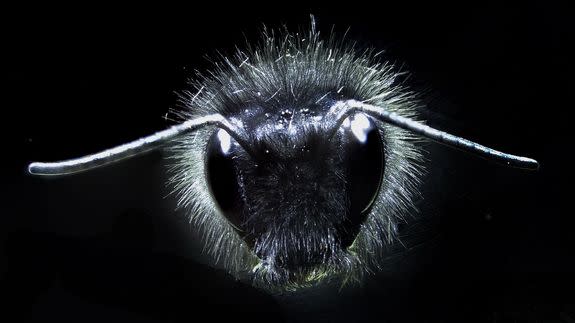Tiny hairs enable bumblebees to detect electrical fields: study finds

Bumblebees are known for some impressive physical feats, including the ability to fly at high altitudes and see ultraviolet light. In 2013, a study added a new superpower to the bees’ arsenal when researchers discovered that they’re actually able to detect electric fields — a special sense that can help them forage by enabling them to sense electrical charges on flowers.
Until that discovery was made, scientists had thought that detecting electric fields was an ability limited to animals who live in the water or very moist environments, since water can conduct electric currents.
SEE ALSO: These cloud maps track life on Earth in beautiful detail
The fact that bees could do it in dry air was something of a mystery, and scientists weren’t sure how it was happening.
But now a new study, published Monday in Proceedings of the National Academy of Sciences, has helped shed some light on the bees' amazing abilities. The study suggests that electric fields can exert a physical force on a bumblebee’s tiny body hairs and cause them to move — and these hairs then relay nerve signals to the brain in response.
When the researchers first set out to conduct their study, they had two hypotheses: the answer lay either in the bees’ antennae, which are sensitive to a variety of different types of stimuli, or in the tiny hairs on the bees’ bodies called “mechanosensory hairs.” There’s evidence in the scientific literature that supports both ideas.
Previous research has suggested that honeybees — domesticated cousins of the bumbles — might be able to detect electric fields with their antennae, although some scientists think more research is needed on that front.
On the other hand, some studies have suggested that insect body hairs can detect all sorts of small forces associated with things like sound or the flowing of fluids — so electric fields may not be a stretch.
They started with the antennae.
“We had this hypothesis that maybe an electrical field would cause a motion in the antenna, just like when you rub your hair on a balloon and you move the balloon away and it pulls on your hair,” said Gregory Sutton, the study’s lead author and a Royal Society research fellow at the University of Bristol. “We were thinking the static force could move an antenna.”

Image: PHILIPPE HUGUEN/AFP/Getty Images
It turns out they were right — about the motion part, at least. When antennae were stimulated with an electric field, the researchers found that they did, in fact, move in response. But when they tested the bees’ body hairs, they found an even greater reaction.
After performing a handful of different tests, the researchers found that the body hairs were more sensitive to electric fields and moved faster in response than the antennae.
The most telling result, however, was that the motion in the body hairs was accompanied by a response from the nervous system — and this was not true for the antennae. When the researchers stimulated the bees’ antennae with an electric field, there was no change in the antennae’s nerve cell activity.
On the other hand, they found that stimulating the body hairs caused a significant increase in the activation of nerve cells.
These results suggest that the bees’ body hairs — and not the antennae — are the secret to the bumblebee’s extraordinary ability. And the study also comes with the tantalizing possibility that other insects may be harboring the same talent.
As Sutton explained, the hairs on a bumblebee aren’t remarkably sensitive within the insect world — they’re actually pretty average. There are plenty of bugs out there whose body hairs are just as sensitive, if not more so, which suggests that other critters may be able to sense electric fields as well.
If this turns out to be true, there are a variety of ways this ability could be useful to insects beyond just finding flowers, Sutton noted.
Many insects — bees included — have electrical charges on their bodies, for instance. The ability to detect electric fields could enable insects to better sense when another bug — perhaps one they’d like to eat (or one they’d like to escape) — is coming along.
Of course, more research will be necessary to determine if this is, in fact, the case. But in the meantime, the bumblebee study provides a new window into the natural world, demonstrating that there are still new things to be learned about the insects we encounter every day.
“This paper is about bumblebees doing something that no one thought any terrestrial animal could do,” Sutton said.
“This is not the first time one of the everyday insects we encounter on a daily basis has been shown to do something wild and crazy, and this will by no means be the last. This just shows us that we really don’t know much about the insects we deal with on a day-in and day-out basis.”
